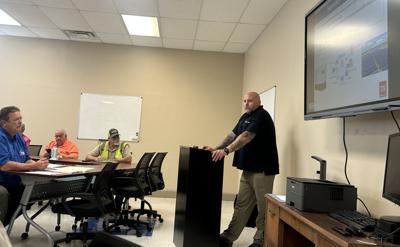BLOUNTVILLE — Emergency officials and local leaders gathered on Wednesday to review and suggest potential hazard mitigation projects in Sullivan County, part of an ongoing planning process that could unlock FEMA funding for long-term safety improvements.
FEMA stands for the Federal Emergency Management Agency.
Michael Lamphere, East Regional planner for the Tennessee Emergency Management Agency, led the meeting, which focused on updating the county’s hazard mitigation plan. He discussed projects the county could take on which would be eligible for federal funding through FEMA’s Hazard Mitigation Grant Program.
That funding, if awarded, can help reduce the risks posed by natural disasters such as flooding, tornadoes, landslides and wildfires.
Lamphere walked attendees through dozens of examples that local governments across Tennessee have successfully applied for in recent years. These include buying flood-prone properties to convert into public green space, elevating structures, reinforcing roads that routinely flood and installing safe rooms in existing schools or community buildings.
“Tornadoes are big in Tennessee. You can apply for a project to put a safe room inside a school or community center,” Lamphere said, noting that those projects must be for already-built public facilities. “They won’t cover it if the building is still under construction.”
Other examples of eligible projects included backup generators for critical public buildings, culvert installations, floodwater diversion for roadways, window films to prevent shattering during storms and community education programs for wildfire prevention and drought preparedness.
The county is also considering a Firewise designation, which would help educate the public on wildfire risks and prepare local neighborhoods for fire mitigation. Kingsport recently added a Firewise compliance project to the county’s mitigation plan.
While FEMA won’t fund short-term fixes like equipment purchases or dredging streams, Lamphere encouraged communities to think long-term.
“This is your opportunity to identify areas that flood, roads that wash out or other vulnerabilities and submit ideas for improvement,” he said.
Mitigation projects already added to Sullivan County’s updated plan include:
- Becoming Firewise compliant
- Installing a generator for the county’s sewer and water plant
- Adding generators to county offices and the Emergency Operations Center
Each jurisdiction must submit at least one project per identified hazard, Lamphere said, and he urged local agencies to work with Sullivan County Emergency Medical Agencay or EMA Director Jim Bean to submit project ideas — even if they arise years from now.
“If you’ve got an idea two years down the road, you can still submit a simple one-page form,” Lamphere said. “As long as your jurisdiction is included in the plan, you can apply for funding anytime.”
Lamphere noted that FEMA’s approval timelines have significantly improved.
“Projects that used to take two to five years to get approved are now coming back within months,” he said.
Lamphere said 85% of the county’s updated hazard mitigation plan is complete. He relies on FEMA-required data, simulations from East Tennessee State Univeristy on droughts and climate conditions and hazard modeling such as “Hazus,” a FEMA tool that simulates disaster impacts.
“For example, if an earthquake with a 6.5 magnitude occurred in Madisonville, Hazus would estimate how many buildings would be damaged and the financial cost,” Lamphere said.
Although earthquake events are rare, Lamphere encouraged local jurisdictions in East Tennessee to include earthquakes in their hazard profiles.
“You’re sitting near the Eastern Tennessee seismic zone,” he said. “If it’s not in the plan, FEMA won’t provide funding for it.”
Once complete, the plan must go to TEMA in Nashville, then FEMA, which has 60 days to review it.
“They’ll either approve it pending adoption or kick it back for revisions,” Lamphere said. “Sometimes it’s just missing details, like the depth of flooding at a known intersection. FEMA wants that to be in inches or feet.”
Once FEMA gives its conditional approval, each city and county government must adopt the plan through a resolution. That step activates a five-year eligibility window for federal funding.
Lamphere said that even if the current plan expires in August before the new one is approved, the lapse won’t affect jurisdictions retroactively—but new project applications can’t move forward until the new plan is approved.
Lamphere said that jurisdictions that do not adopt the updated plan will be excluded from federal funding opportunities.
“If three jurisdictions approve it and one doesn’t, that won’t affect the other three,” he said. “But the one that doesn’t adopt won’t be eligible for hazard mitigation funding.”









